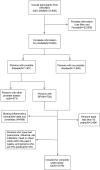The relationship between complete blood cell count-derived inflammatory biomarkers and benign prostatic hyperplasia in middle-aged and elderly individuals in the United States: Evidence from NHANES 2001-2008
- PMID: 38980876
- PMCID: PMC11233019
- DOI: 10.1371/journal.pone.0306860
The relationship between complete blood cell count-derived inflammatory biomarkers and benign prostatic hyperplasia in middle-aged and elderly individuals in the United States: Evidence from NHANES 2001-2008
Abstract
Background: Benign prostatic hyperplasia (BPH) is a common health disorder of the male genitourinary system with a high prevalence, especially among middle-aged and older adults, which seriously affects men's quality of life. Inflammatory markers derived from complete blood cell count (CBC) have previously been considered a prognostic indicator for various diseases, but little is known about their relationship with BPH. This study evaluated the relationship between complete blood cell count (CBC)-derived inflammatory biomarkers and BPH.
Methods: Data for this cross-sectional study were gathered from the National Health and Nutrition Examination Survey (NHANES) between 2001 and 2008. Using multiple logistic regressions, the study examined the association between benign prostatic hyperplasia(BPH) and Inflammatory biomarkers derived from blood cell counts such as neutrophil-to-lymphocyte ratio (NLR), platelet-to-lymphocyte ratio (PLR), monocyte-to-lymphocyte ratio (MLR), Systemic Inflammatory Response Index (SIRI) and Systemic Immunoinflammatory Index (SII).
Results: 3,919 participants were included, with a median age of 61.00 (52.00-71.00) years old. Among them, 609 participants had benign prostatic hyperplasia, with a prevalence of 15.54%. Upon accounting for confounding factors, the study revealed a positive correlation between the plurality of BPH PLR and SII. However, MLR, NLR, and SIRI did not significantly correlate with the prevalence of BPH (p>0.05). In contrast to the lowest quartile, higher quartiles of PLR (OR = 1.93[1.38-2.69]) and SII (OR = 1.71[1.22-2.40]) were linked to an elevated risk of BPH. Interaction tests showed that age, body mass index, hypertension, diabetes, smoking, and drinking had no significant effect on this positive correlation (p for interaction>0.05). In addition, we found a roughly linear association between SII, PLR, and BPH using smoothed curve fitting.
Conclusions: According to our research, high levels of PLR and SII are positively linked with an increased risk of BPH in middle-aged and elderly individuals in the United States. The results compensate for previous studies that still need to be validated with larger prospective cohorts.
Copyright: © 2024 Shi et al. This is an open access article distributed under the terms of the Creative Commons Attribution License, which permits unrestricted use, distribution, and reproduction in any medium, provided the original author and source are credited.
Conflict of interest statement
The authors have declared that no competing interests exist.
Figures




Similar articles
-
The relationship between complete blood cell count-derived inflammatory biomarkers and erectile dysfunction in the United States.Sci Rep. 2024 Dec 30;14(1):32014. doi: 10.1038/s41598-024-83733-5. Sci Rep. 2024. PMID: 39738513 Free PMC article.
-
Association between blood inflammatory indices and heart failure: a cross-sectional study of NHANES 2009-2018.Acta Cardiol. 2024 Jun;79(4):473-485. doi: 10.1080/00015385.2024.2356325. Epub 2024 May 21. Acta Cardiol. 2024. PMID: 38771356
-
Association between complete blood count-derived inflammatory markers and the risk of frailty and mortality in middle-aged and older adults.Front Public Health. 2024 Jul 31;12:1427546. doi: 10.3389/fpubh.2024.1427546. eCollection 2024. Front Public Health. 2024. PMID: 39145178 Free PMC article.
-
From Cell Interactions to Bedside Practice: Complete Blood Count-Derived Biomarkers with Diagnostic and Prognostic Potential in Venous Thromboembolism.J Clin Med. 2025 Jan 2;14(1):205. doi: 10.3390/jcm14010205. J Clin Med. 2025. PMID: 39797287 Free PMC article. Review.
-
Inflammatory Hematological Indices, Cardiovascular Disease and Mortality: A Narrative Review.Arq Bras Cardiol. 2024 Aug 26;121(7):e20230752. doi: 10.36660/abc.20230752. eCollection 2024. Arq Bras Cardiol. 2024. PMID: 39193999 Free PMC article. Review. English, Portuguese.
Cited by
-
The relationship between complete blood cell count-derived inflammatory biomarkers and erectile dysfunction in the United States.Sci Rep. 2024 Dec 30;14(1):32014. doi: 10.1038/s41598-024-83733-5. Sci Rep. 2024. PMID: 39738513 Free PMC article.
-
Exploring the association between caffeine intake and benign prostatic hyperplasia: results from the NHANES 2005-2008.Front Nutr. 2025 Jan 13;11:1511607. doi: 10.3389/fnut.2024.1511607. eCollection 2024. Front Nutr. 2025. PMID: 39872138 Free PMC article.
-
The Relationship Between Immune-Inflammatory Indexes and the Severity of Lower Urinary Tract Symptoms/Benign Prostatic Hyperplasia: A Cross-Sectional Study at a Tertiary Hospital in China.J Inflamm Res. 2025 Jun 27;18:8509-8523. doi: 10.2147/JIR.S523193. eCollection 2025. J Inflamm Res. 2025. PMID: 40599693 Free PMC article.
-
Analysis of changes in platelet parameters and inflammatory markers in intrahepatic cholestasis of pregnancy before disease development.Am J Transl Res. 2024 Dec 15;16(12):7448-7457. doi: 10.62347/OWXV5949. eCollection 2024. Am J Transl Res. 2024. PMID: 39822511 Free PMC article.
-
The association between eight complete blood count-derived inflammatory markers and muscle health.Front Nutr. 2025 Feb 3;12:1498757. doi: 10.3389/fnut.2025.1498757. eCollection 2025. Front Nutr. 2025. PMID: 39963665 Free PMC article.
References
MeSH terms
Substances
LinkOut - more resources
Full Text Sources
Medical

